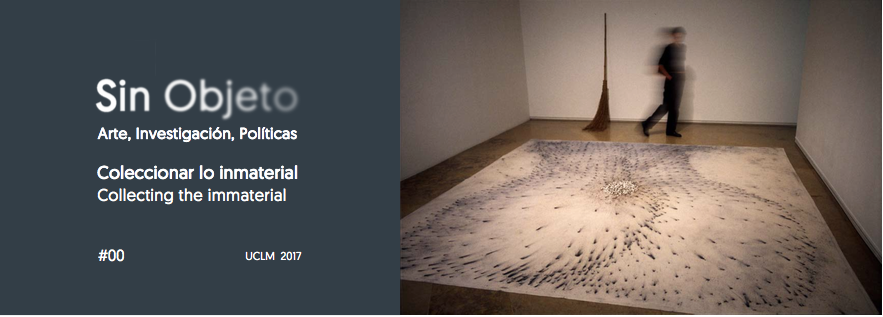The Illogic of Sehgal. Performance, Experience and Immaterial Economy in Tino Sehgal´s Work
Main Article Content
Abstract
Tino Sehgal is one of the most acclaimed artists of recent years. His work consists of situations interpreted by hired performers. Those situations, designed for museums, biennials and galleries around the world, never produce material traces: photographs, objects, scores or contracts of his pieces could not be displayed, published or collected. This paper explores some of the contradictions related to Sehgal´s conceptualization of artistic labour, its position in the international art system, and the strategies that he has developed in order to avoid the hegemonic institutional and commercial inertias.
Article Details
Todos los artículos de la revista, están sujetos a una licencia Creative Commons del tipo Reconocimiento - NoComercial - Sin Obra Derivada
References
Albarrán Diego, J. (2012). La fotografía ante el arte de acción. Efímera, 3.
Alberro, A. (2003). Conceptual Art and the Politics of Publicity. Cambridge: MIT.
Auslander, P. (1999). Liveness: Performance in a Mediatized Culture. New York: Routledge.
Auslander, P. (2006). The Performativity of Performance Documentation. PAJ, 28(3).
Auslander, P. (2014). Surrogate Performances. Performance, Documentation and the New York Avant-Garde ca. 1964-1974. En E. Carpenter (ed), On Performativity. Minneapolis: Walker Art Center. Recuperado de http://www.walkerart.org/collections/publications/performativity/surrogate-performances/
Biesenbach, K.; Obrist H.U. (2013). 13 Rooms. Sydney, Kaldor Public Art Projects.
Biesenbach, K.; Obrist H.U. (2014). 14 Rooms. Basel: Hatje Cantz.
Bishop, C. (2005). No Pictures, Please. Artforum, mayo.
Bishop. C. (2014a). The Perils and Possibilities of Dance in the Museum: Tate, MoMA, and Whitney. Dance Research Journal, 46(3).
Bishop. C. (2014b). Je ne veux pas de rétrospective: Xavier Le Roy et l´exposition en tant que médium. En B. Cvejic (ed), Rétrospective par Xavier Le Roy. Paris: Les Presses du Réel.
Cahier (2015). Cahier Interviews Beatrix Ruf. Cahier 27. Recuperado de http://www.cahier-online.de/news/cahier27-news_e.html
Carpenter, E. (2014). Be the Work: Intersubjectivity in Tino Sehgal’s This objective of that object. En E. Carpenter (ed), On Performativity. Minneapolis: Walker Art Center. Recuperado de http://walkerart.org/collections/publications/performativity/be-the-work.
Cattelan, M. (2009). Tino Sehgal: Economics of Progress. Flash Art, 264.
Christov-Bakargiev, C. (2012). dOCUMENTA (13). The Guidebook. Catalog 3/3. Kassel: dOCUMENTA, Hatje Cantz.
Davis, B. (2010). Photos for Tino. Artnet. Recuperado de http://www.artnet.com/magazineus/reviews/davis/tino-sehgal1-7-10.asp
Estella, I. (2015). El arte de performance a debate: originalidad, re-escenificación y los modelos alternativos de George Maciunas. Ars Longa, 24.
Griffin, T. (2005). Tino Sehgal: An Interview. Artforum, mayo.
Heiser, J. (2004). Tino Sehgal. En Funky Lessons. Berlín: BüroFriedrich.
Hinojosa, L. (2015). Objetualizar la experiencia, historiar la ausencia. Notas sobre performance y museos. En J. Albarrán e I. Estella (Eds.), Llámalo performance: historia, disciplina y recepción. Madrid: Brumaria.
Kravchuk, D. (2016). Tino Sehgal. A Year in the Stedelijk. Mu[see]um. Recuperado de http://www.museeum.net/article/188/martijn-van-niewenhuyzen.html
Kunst, B. (2015). Artist at Work. Proximity of Art and Capitalism. Winchester, Washington: Zero Books.
Lydiate, H.; McClean, D. (2011). Re-Performance Art. Art Monthly, 349.
Morgan, R.C. (2010). Thoughts on Re-performance, Experience, and Archivism. PAJ, 32(3).
Obrist, H.U. (2003). Hans Ulrich Obrist Interviews Tino Sehgal. En Katalog des Kunstpreises der Böttcherstaße. Bremen: Kunsthalle.
Obrist, H.U. (2013). do it. The Compendium. New York: Independent Curators International.
Richard, S. (2009). Unconcealed. The International Network of Conceptual Artists 1967-1977. Dealers, Exhibitions and Public Collections. London: Ridinghouse, Norwich University College of the Arts.
Vila-Matas, E. (2014). Kassel no invita a la lógica. Barcelona: Seix Barral.
Virno, P. (2003). Virtuosismo y revolución: notas sobre el concepto de acción política. En Virtuosismo y revolución. La acción política en la era del desencanto. Madrid: Traficantes de Sueños.
Von Hantelmann, D. (2010). How to Do Things with Art. Zurich: JRP / Ringier.
Wood, C. (2014). In Advance of the Broken Arm: Collecting Live Art and the Museum´s Changing Game. En T. Calonje (ed), Live Forever. Collecting Live Art. London: Koenig.
